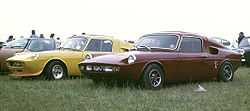Unipower
| Unipower GT | |
|---|---|
 | |
| Overview | |
| Manufacturer | Universal Power Drives Ltd |
| Production | 1966-1975 75 made |
| Body and chassis | |
| Body style | 2-door coupé |
| Powertrain | |
| Engine | 998 or 1275 cc Straight-4 |
| Transmission | 4 speed manual |
| Dimensions | |
| Wheelbase | 84 inches (2134 mm)[1] |
| Length | 164 inches (4166 mm)[1] |
| Width | 57 inches (1448 mm)[1] |
The Unipower GT was a British specialist sports car first shown at the January 1966 Racing Car Show, and produced by truck maker Universal Power Drives Ltd in Perivale, Middlesex and later by U.W.F. Automotive in London until production ceased in early 1970, by which time around 75 are believed to have been made, including about 15 built by U.W.F..
The car was based on BMC Mini mechanical components with the transverse engine and gearbox unit mounted in a mid-engine configuration. A strong spaceframe chassis with integral roll-over protection was bonded to a fibreglass body to produce a light yet rigid structure, with all-round independent coil spring and wishbone suspension. Combining light weight, a low centre of gravity and low aerodynamic drag from a body that measured just 40.5 inches (1,029 mm) high, the Unipower offered very good performance and excellent road holding and handling characteristics. Available with the 998 cc Mini-Cooper or more potent 1275 cc Cooper "S" engine, this later version was reported to be capable of 0-60 mph in around 8 seconds and to have a maximum speed of almost 120 mph (193 km/h).
A design was produced for a larger Unipower but this did not go into production with the original makers instead eventually evolving into the AC ME3000.
Unipower also made a limited number of the "glass box" Quasar-Unipower cars.
| Wikimedia Commons has media related to Unipower vehicles. |